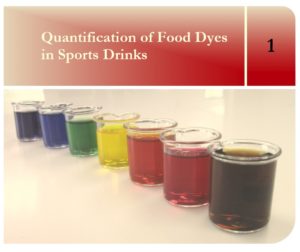Absorbance Spectroscopy and Sports Drinks
How much food dye is present in sports drinks? This is the question you will answer in this laboratory experiment. You will use visible spectroscopy to determine the concentration of a food dye in a beverage of your choice. This requires that you understand how light and matter interact – specifically how light is transmitted and absorbed species in a solution. You will design a method to create standard dye solutions and use these standards to generate a calibration curve. You will then use Beer’s law to quantify the amount of food dye in your beverage. You will use your results to comment on the safety of food dyes in beverages.
Learning Goals
As a scientist, you are often tasked with identifying and quantifying unknown compounds or solutions. What and how much of an unknown compound is present in a sample? For example, a stream or river may need to be analyzed for the presence of certain harmful chemicals such pesticides. First, you would want to identify the pesticide species present in the waterway. You would then want to quantify the amount of each pesticide present. In this experiment, you focus on food dyes in beverages. You will quantify the amounts of food dye in a drink of your choice using UV-Vis spectroscopy and Beer’s law.
Food Dyes
Food dyes are used in many common beverages and foods.1 While food dyes serve no nutritional purpose, they provide an attractive color to many different sports or soft drinks, desserts, and even meat. Odds are you have consumer many beverages or food that contain food dye – a colored sports drink after a hard workout, a cupcake decorated with red frosting, or a piece of colored candy. Dying food and drinks is a not a new art. Indeed, food dyes have been reported since ancient times. While some historic food dyes were harmless (chalk was added to bread to make it ‘whiter’) there was a trend in the 17th and 18th century to use brightly colored but toxic inorganic salts (such as lead chromate, mercury sulfide) to improve the color of food.2 By the mid-19th century nearly every food or drink was adulterated and the safety of the compounds added to food was receiving widespread attention.
The food dye landscape changed dramatically once the first synthetic dyes were produced. The first synthetic organic dye, “aniline purple” or “mauve”, was created by William Perkin in 1856. 3 These synthetic dyes quickly replaced the old unsafe inorganic dyes in food products. However, the safety of these new dyes had not been proven. Over the next century, what was to become known as the FDA tested and approved or rejected numerous synthetic dyes for food consumption. However, the safety of food dyes is still under debate. For example, the FDA considers powdered Red 3 safe, but a different form of this same dye is banned because it is carcinogenic to rats. 4 In the 1970s, several studies found that FD&C Yellow 5 and Yellow 6 cause allergic reactions and hyperactivity in children. 5,6 Currently the United States permits seven synthetic foods dyes – FD&C Red 3, Red 40, Yellow 5, Yellow 6, Blue 1, Blue 2, and Green 3. You will investigate FD&C Red 40, Yellow 5, and Yellow 6 in this experiment.





